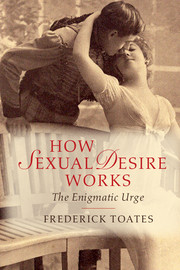Book contents
- Frontmatter
- Dedication
- Contents
- List of figures
- Preface
- One What is enigmatic about sexual desire?
- Two Explaining desire: multiple perspectives
- Three Sexual desire in a broad context
- Four An incentive-based model
- Five Sex and levels of organization
- Six Sexual attraction
- Seven Shades of desire from simple to complex
- Eight Details of the brain and desire
- Nine Arousal
- Ten The consequences of sexual behaviour and associated expectations
- Eleven Sexual familiarity and novelty
- Twelve Inhibition, conflict and temptation
- Thirteen How did sexual desire get here?
- Fourteen Setting the trajectory: link to adult sexuality
- Fifteen Sexual desire in interaction
- Sixteen Representations of sex
- Seventeen Sexual addiction
- Eighteen Variations in desire: general principles
- Nineteen Some forms of desire at the fringes
- Twenty The toxic fusion: violence and sexual desire
- Twenty one Sexually associated (serial) murder
- Twenty two Concluding remarks
- Notes
- References
- Index
Eleven - Sexual familiarity and novelty
Published online by Cambridge University Press: 05 October 2014
- Frontmatter
- Dedication
- Contents
- List of figures
- Preface
- One What is enigmatic about sexual desire?
- Two Explaining desire: multiple perspectives
- Three Sexual desire in a broad context
- Four An incentive-based model
- Five Sex and levels of organization
- Six Sexual attraction
- Seven Shades of desire from simple to complex
- Eight Details of the brain and desire
- Nine Arousal
- Ten The consequences of sexual behaviour and associated expectations
- Eleven Sexual familiarity and novelty
- Twelve Inhibition, conflict and temptation
- Thirteen How did sexual desire get here?
- Fourteen Setting the trajectory: link to adult sexuality
- Fifteen Sexual desire in interaction
- Sixteen Representations of sex
- Seventeen Sexual addiction
- Eighteen Variations in desire: general principles
- Nineteen Some forms of desire at the fringes
- Twenty The toxic fusion: violence and sexual desire
- Twenty one Sexually associated (serial) murder
- Twenty two Concluding remarks
- Notes
- References
- Index
Summary
‘I know how to love best. I am your servant, your concubine! You are my king, my idol! You are good, you are beautiful, you are clever, you are strong!’
He had heard so often these things said that they did not strike him as original. Emma was like all his mistresses, and the charm of novelty, gradually falling away like a garment…”
(Gustave Flaubert, 1856/2010, p. 317)If it is true that variety is essential for the maintenance of a normal, active sex life – at least for a substantial majority of the male population and for a certain proportion of females as well – then our social ideals of life-long enforced monogamy and sexual exclusivism are contrary to nature and a constantly festering source of cultural and individual pathology and discontent. Yet, this need for variety is exactly what all the scientific evidence from both human and animal studies seems to indicate beyond any reasonable doubt.”
(Kronhausen and Kronhausen, 1967, p. 180)Basic principles
As a general principle applicable across various sexual and non-sexual situations, a wide range of species, for example rats, monkeys and humans, show a preference for some novelty (Bardo et al., 1996). That is to say, the brain is particularly sensitive to change in what arrives at the sense organs relative to an unchanging pattern of stimulation. In experiments, animals work to achieve change in their physical environment, for example by pressing a lever to alter the illumination or gaining access to a visual image.
In various species, humans included, novelty can be a powerful stimulus to sexual desire and points to the role of the external incentive. Desire can be re-ignited in a so-called ‘sexually satiated’ animal, human or non-human, when a new partner appears (Schein and Hale, 1965). Arousal by novelty suggests that motivation arises from an interaction between an internal factor, now re-sensitized, and the incentive.
- Type
- Chapter
- Information
- How Sexual Desire WorksThe Enigmatic Urge, pp. 188 - 198Publisher: Cambridge University PressPrint publication year: 2014

